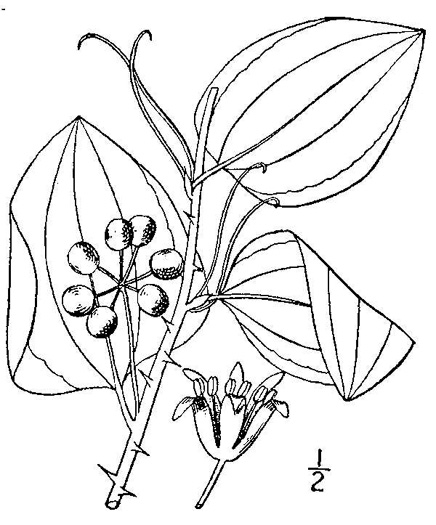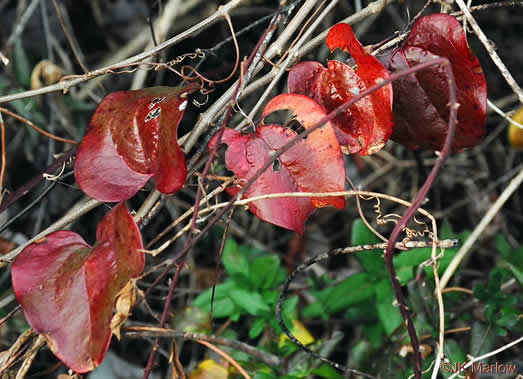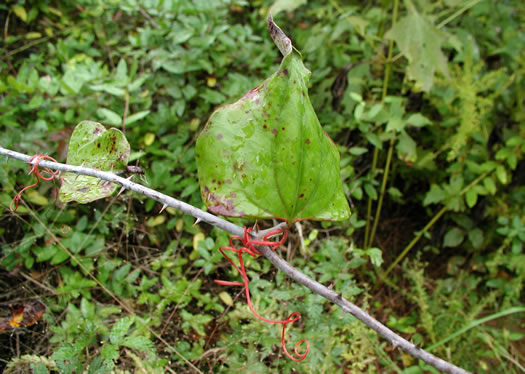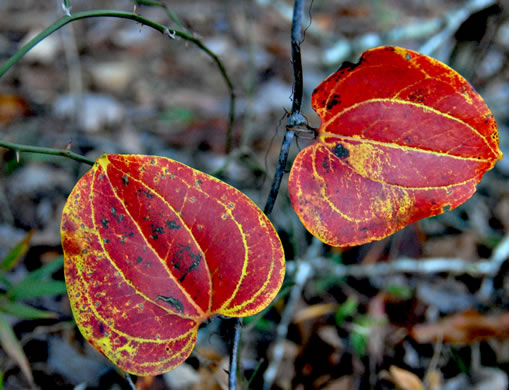Spermatophytes (seed plants): Angiosperms (flowering plants): Monocots: Liliales
WEAKLEY'S FLORA OF THE SOUTHEASTERN US (4/24/22):
Smilax glauca
FAMILY
Smilacaceae
Go to FSUS key
Dig deeper at SERNEC, a consortium of southeastern herbaria.
You may also want to check Trees, Shrubs, and Woody Vines of North Carolina
Learn more from the Vascular Plants of North Carolina website.
SYNONYMOUS WITH
PLANTS NATIONAL DATABASE:
Smilax glauca
FAMILY
Smilacaceae
SYNONYMOUS WITH Floristic Synthesis of North America. BONAP (Kartesz, 2021)
Smilax glauca
SYNONYMOUS WITH Flora of North America
Smilax glauca
INCLUDING Floristic Synthesis of North America (Kartesz, 1999)
Smilax glauca var. glauca
INCLUDING Floristic Synthesis of North America (Kartesz, 1999)
Smilax glauca var. leurophylla
SYNONYMOUS WITH VASCULAR FLORA OF THE CAROLINAS (Radford, Ahles, & Bell, 1968) 041-02-007:
Smilax glauca FAMILY Liliaceae
SYNONYMOUS WITH The woody Smilaxes of the United States (Coker, 1944)
Smilax glauca
SYNONYMOUS WITH Manual of the Southeastern Flora (Small, 1933, 1938)
Smilax glauca
COMMON NAME:
Whiteleaf Greenbrier, Wild Sarsaparilla, Sawbrier
To see larger pictures, click or hover over the thumbnails.
JK Marlow jkm0401c_05
January Pickens County SC
Roadside
Climbing or scrambling woody vine with thorns, 2-20m long, per Forest Plants of the Southeast and Their Wildlife Uses (Miller & Miller, 2005).
JK Marlow jkm0401c_06
January Pickens County SC
Roadside
SC's only species of Smilax with leaves whitish beneath, per Guide to the Wildflowers of SC, 1st ed. (Porcher & Rayner, 2001).
JK Marlow jkm200602_5579
June Spartanburg County SC
Lower stem often bristly. Leaves often variegated with lighter green above, per Vascular Flora of the Carolinas (Radford, Ahles, & Bell, 1968).
WEAKLEY'S FLORA OF THE SOUTHEASTERN US (4/24/22):
Smilax glauca
FAMILY
Smilacaceae
SYNONYMOUS WITH
PLANTS NATIONAL DATABASE:
Smilax glauca
FAMILY
Smilacaceae
SYNONYMOUS WITH
Floristic Synthesis of North America. BONAP (Kartesz, 2021)
Smilax glauca
SYNONYMOUS WITH
Flora of North America
Smilax glauca
INCLUDING
Floristic Synthesis of North America (Kartesz, 1999)
Smilax glauca var. glauca
INCLUDING
Floristic Synthesis of North America (Kartesz, 1999)
Smilax glauca var. leurophylla
SYNONYMOUS WITH
VASCULAR FLORA OF THE CAROLINAS (Radford, Ahles, & Bell, 1968) 041-02-007:
Smilax glauca
FAMILY
Liliaceae
SYNONYMOUS WITH
The woody Smilaxes of the United States (Coker, 1944)
Smilax glauca
SYNONYMOUS WITH
Manual of the Southeastern Flora (Small, 1933, 1938)
Smilax glauca
If a search such as "Carex leptalea var. leptalea" doesn't deliver the results you want, try "Carex leptalea".
Or, to minimize chances of a misspelling, try just "Carex le".
Less is more: If "pencil flower" doesn't deliver the results you want, try "pencil".








